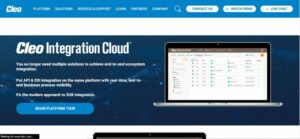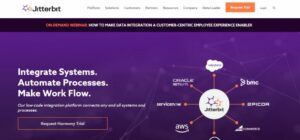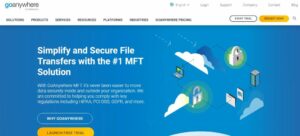To assist you in making an informed choice, we’ll analyse the finest EDI software options available in this post. Data is sent electronically from one system to another using a set of standards known as EDI, or Electronic Data Interchange.
EDI has lived in use since the 1960s and is now prevalent across almost all industries. It’s crucial to remember that EDI is a set of standards rather than software.
Top 8 Best EDI Software In 2022
In this article, you can know about edi software here are the details below;
As a result, it needs an additional service, which EDI suppliers offer. As part of an EDI solution, an EDI provider may provide services like mapping, testing, and trade partner integration.
Why use EDI?
The main advantages of EDI are the decreased errors and increased productivity. Data is automatically transferred between two computer systems while using EDI as opposed to manually entering it.
By eliminating the requirement for human involvement, the procedure becomes quicker and more precise. Additionally, it reduces the need for expensive paper documentation, saving both money and time. Due to the quicker payment of electronic invoices compared to paper ones, EDI also helps to increase cash flow.
EDI Software: An Overview
A brand-new category of software called EDI Software is intended to boost your company’s productivity. It was developed with the purpose of giving your organisation a way to organise information, enabling you to enhance operations and make better business decisions.
You must comprehend how this kind of software can be useful to you. Using this kind of software has a number of advantages, such as the flexibility it offers for handling everything from appointments and inventory to sales and software information.
Additionally, it can be used for promotion and marketing. In conclusion, there is no reason not to consider adopting EDI Software if you have information that needs to be controlled.
This kind of software is particularly well-liked by businesses who require it because it is so simple to use. Because it was created with businesses in mind, it is simple to use and has a very intuitive user interface.
For instance, even if you have never used an ERP system or customer relationship management (CRM) software, you should have no trouble picking up on how to use this one right away.
What EDI software is the best?
Efficiency is frequently the key when it comes to business. But in the age of digital revolution, efficiency can imply many different things.
In actuality, digital transformation covers a wide range of procedures that can improve the productivity of your business.
What Exactly Is a Digital Transformation? The process of utilising technology to enhance various business operations is known as digital transformation. This could be utilising cutting-edge software to simplify processes or utilising new technologies to improve customer experience or contact with clients or suppliers.
What is EDI Software? Any way you decide to integrate technology into your business model is seen as a sort of digital transformation. Electronic Data Interchange is what EDI stands for. Using EDI software, companies can electronically exchange common documents like invoices, purchase orders, and shipment notifications.
Modern information exchange is fundamentally made possible by EDI software by moving it away from paper and toward electronic means. This enables companies to migrate to paperless operations and lessen their dependency on paper-based processes.
EDI Software: Why Use It? There are a combination of reasons why you might wish to incorporate EDI software into your business strategy. Paperless Processes: As discussed previously, reducing your reliance on paper is one of these reasons.
1. Cleo Integration Cloud

Using the all-in-one connection platform Cleo Integration Cloud, businesses can improve their flexibility and agility while lowering their risk. Companies may interact with any application or data source, anywhere and at any time, using a single platform that offers pre-built integrations, connectors, and AI-driven automation.
The enterprise is the target market for Cleo Integration Cloud. Batch processing, high availability, disaster recovery, security, data compliance, and other functions on the platform execute exceptionally well.
The Integration forum as a Service (iPaaS) feature of the Cleo Integration Cloud platform allows users to connect apps instantly and without the need for scripting using drag-and-drop tools and thousands of pre-built application connectors.
Managed File Transfer (MFT) – Use secure protocols and encryption to automate file transfers locally or in the cloud. Create APIs based on microservices and orchestrate them using a simple drag-and-drop workflow designer with API management.
Utilize Cleo’s Hybrid Connector for hybrid integration to move data securely between environments by connecting on-premises and cloud apps. Data transformation: To transform data without coding, utilise a graphical user interface—or, if necessary, custom code.
Features
Connect data, applications, and people with Cleo Integration Cloud Features. API Management. A unmarried, integrated platform for all of your APIs. Create, publish, maintain, and keep an eye on APIs that safely link the app and data worlds.
Centralized Management Keep track of data about all of your APIs in one place. With customised roles and extensive access controls, you can govern users and permissions across your whole organisation. Secure Your APIs The Cleo Integration Cloud gives you a safe environment in which to create connectors for external systems.
Data is transferred between the Cleo Integration Cloud and outside systems using the HTTPS protocol. The use of this protocol to create secure connections between web servers and clients has become the norm.
Drag and drop connectors onto the canvas to create new integrations or map data without writing any code. To get started right away, use our huge library of prebuilt connections & templates!
Pros
You can quickly link all of your systems, partners, and clients thanks to Cleo Integration Cloud, a robust integration platform. For speed and agility, it is designed on a microservices-based architecture, and as it is constantly updated, you don’t have to worry about versioning or updates.
The components of the Cleo Integration Cloud are as follows: Cleo Integration Studio, a graphical user interface for managing integration; Cleo Harmony, a self-service hub that automates the process of connecting business users’ apps.
Cleo VLTrader is an enterprise-level B2B gateway that offers secure cloud data transfer, high-volume data transformation, and communications services. Cleo VLTrader Gateway and Managed Services are safe and reliable B2B managed services provided on Cleo’s private cloud.
2. SPS Commerce Fulfillment

You can manage inventory and orders across your whole network of clients, partners, and suppliers thanks to our fulfilment solutions. As you expand into new sales channels or distribution hubs, you may automate fulfilment, save money, and increase the accuracy of delivery.
SPS Commerce Fulfillment enables you to meet the needs of a diverse spectrum of customers, including those of web businesses, brick and mortar stores, and mobile customers. Customer portal solutions for e-commerce and brick & mortar merchants
Utilize our customer interface to accept and complete orders from numerous consumers with ease. For brick-and-mortar and online businesses, supplier portal solutions are available. With SPS Commerce Fulfillment, you can send purchase orders directly to suppliers and follow modifications to guarantee that goods are delivered on time.
Suppliers may quickly retrieve order information and start shipping from the cloud using our supplier portal. Solutions from partners to expand your network Use SPS Commerce Fulfillment to take your supply chain management procedures outside of your office.
By automating order management procedures, partner portals enable 3PLs and other trading partners to collaborate with you more successfully and save time on data entry.
Features
Inventory management SPS Commerce Fulfillment Features Manage and monitor your inventory levels in real time. Understand where, when, and where your stock is coming from.
Fulfilling orders Complete orders directly from the cloud – no ERP system is required. To save time and eliminate mistakes, automate manual procedures like pick-pack-ship. Control your inventory to make sure you always have enough on hand to satisfy demand.
To ensure that you have total visibility into inventory availability, integrate with your internal systems and any supply chain partners. Order management Easily handle orders across all of your company’s sales channels, including web, mobile, brick-and-mortar retail, wholesale, and more.
Pros
We assist you in reaching the correct customers at the appropriate moment with your offerings. SPS Commerce Fulfillment may assist you in taking control of your supply chain and increasing sales, whether through Amazon or other e-commerce channels, whether you manufacture or distribute products. Our fulfilment solutions comprise:
Order management Pick and pack services Shipping management Returns processing Inventory management Real-time inventory visibility in the warehouse
3. TrueCommerce EDI

TrueCommerce has been a pioneer in offering small and medium-sized enterprises an enterprise-class EDI solution for more than 20 years. We offer a complete EDI solution, which consists of the following: EDI Translation Software, which can translate between practically every EDI standard, such as X12, EDIFACT, RosettaNet, EANCOM, and VDA.
You can tailor inbound and outbound translations based on the needs of your trading partners using EDI mapping software. EDI VAN (Value Added Network) services offer safe data transmission across a private network between you and your business partners.
You must be able to handle large quantities of EDI transactions fast and properly in order to fulfil trading partners’ needs and ensure compliance with their various business requirements. By offering a single integration platform that automates the information flow between your company’s systems and those of your trading partners, TrueCommerce reduces the complexity of EDI.
Using TrueCommerce EDI solutions, you can: Automate data interchange with distributors, retailers, and suppliers Save time and money processing orders, invoices, and payments Reduce errors with automatic checks and alerts that highlight problems Boost efficiency by doing away with data re-keying.
Features
TrueCommerce EDI Features We provide a full range of integration solutions that help you connect to any accounting and ERP system. We supply a full scope of connectivity solutions that help you connect to any accounting and ERP system.
A full-featured EDI answer for businesses of all sizes. A full-featured EDI answer for businesses of all sizes. We have the ideal EDI solution for your business, ranging from deployments for a single user to large-scale corporate systems.
We have the ideal EDI solution for your business, ranging from deployments for a single user to large-scale corporate systems. Retail and B2B EDI standards professionals make up our team, and they are prepared to ensure that you obtain the most out of your solution.
Retail and B2B EDI standards professionals make up our team, and they are prepared to ensure that you acquire the most out of your solution.
Pros
The best of both worlds can be found with TrueCommerce EDI. We offer complete EDI services. Every facet of your EDI requirements can be met by our expertise, including: EDI mapping and setup; EDI testing; EDI trading partner compliance; EDI data automation and integration with Sage 100, Sage 500, Sage 300, and all other ERPs.
We’ll collaborate with you to streamline your supply chain operations, cut expenses, and boost profitability.
4. MuleSoft Anypoint Platform

Connect any app, data, or device with MuleSoft Anypoint Platform, whether it’s in the cloud, on-premises, or hybrid. Fast and dependable on-premises and cloud integration without vendor lock-in is made possible by the fact that Anypoint Platform, which includes CloudHubTM and Mule ESBTM, is built on tested open-source software.
Fast and dependable on-premises and cloud integration without vendor lock-in is made possible by the fact that Anypoint Platform, which includes CloudHubTM and Mule ESBTM, is built on tested open-source software. An integrated, single solution for managing complete lifecycle APIs and iPaaS is Anypoint PlatformTM.
Companies can construct composable IT across old systems, manage the whole lifecycle of APIs, and liberate their data with APIs thanks to Anypoint Platform. Fast and dependable on-premises and cloud integration without vendor lock-in is made possible by the fact that Anypoint Platform, which includes CloudHub and Mule ESB, is built on tested open-source software.
Fast and dependable on-premises and cloud integration without vendor lock-in is made possible by the fact that Anypoint Platform, which includes CloudHubTM and Mule ESBTM, is built on tested open-source software. After completing this lab, you will be capable …
Build APIs and integrations easily using Anypoint Platform. With APIkit and Anypoint Exchange, automate API testing. Use the cloud’s Anypoint Platform to deploy your APIs.
Features
A single, unified platform, the MuleSoft Anypoint PlatformTM, can manage the whole API lifetime, from design through management. It offers a simple method for creating integration apps, designing APIs, and managing your complete API programme.
Design, develop, and publish APIs Anypoint Platform makes it simple for developers to construct APIs that are utilised by a variety of applications and devices, including mobile apps, SaaS apps, B2B solutions, and more. With Anypoint Studio, a comprehensive IDE built on Eclipse, you can graphically design and construct APIs.
In order to complete your application flow, connect to any data source. Before deploying your application to the cloud, test it locally in Anypoint Studio. Build integration applications Using the Mule Enterprise Service Bus (ESB), you may create reusable templates for your application logic, saving you time and money.
Build integration apps that connect any assortment of SaaS or corporate applications, whether on-premises or in the cloud, rapidly by using MuleSoft’s visual flow designer. Use CloudHubTM iPaaS to run your app in the cloud and deploy integrations everywhere (integration platform as a service).
Use the Mule runtime engine or servers like Apache Tomcat or WebSphere® to run it locally. the same elements produced by Anypoint
Pros
MuleSoft Anypoint Platform’s benefits include:
Work that is done collaboratively among all of the company’s personnel is made possible. Users can upload and share files, which facilitates collaboration and communication between users in various departments. Additionally, it offers a user management function that enables users to simply control access and rights for their team.
MuleSoft Anypoint Platform offers users a wide variety of tools that may be tailored based on the requirements of the business. To help denizens make the most of the platform, it provides a variety of connectors, templates, and examples. Users may design integration solutions more quickly and effectively thanks to this.
Productivity enhancement MuleSoft Anypoint Platform supports productivity enhancement with a number of features, including data mapping, drag-and-drop functionality, and more. Users no longer need to write numerous lines of code or scripts in order to establish integration solutions thanks to these characteristics.
5. Jitterbit

Jitterbit is a quick and adaptable integration platform that speeds up and makes business process design, implementation, and management across applications, databases, and web services simpler and faster.
The visual development environment of Jitterbit offers an easy method of integration. Integration design is as simple as creating a flowchart.
The platform’s straightforward point-and-click user interface enables dragging and dropping pre-built transformations between source and target systems, positioning them on a canvas, and connecting them with connections to start data transfers. When the visual integration is finished, Jitterbit automatically creates the code.
The project is deployed to production with just one click. In addition, Jitterbit users can examine all data objects and code using any Java IDE because it was designed in EclipseTM. Jitterbit offers a variety of products for companies looking to build their Salesforce integration tools.
The company offers a platform in the cloud that enables companies to connect to other cloud services like Salesforce, Oracle, and NetSuite. Jitterbit also offers an on-premises option that works with existing programmes and services.
Jitterbit’s integration solutions can help businesses improve productivity, reduce costs associated with IT, and streamline their operations.
Features
Jitterbit’s SOAP and REST platform is adaptable and strong, and it can connect to almost any system. Data mapping and transformation are made simple by transformation tools. Reusable templates can be created from powerful transformations.
API Management The cloud integration platform from Jitterbit has an API Manager that streamlines the creation, publication, and management of APIs. Data Quality Jitterbit offers a full range of integrated data quality features to guarantee that data is accurate before it enters your systems.
Business users may easily automate complicated multi-step processes with the Jitterbit Workflow Designer without writing any code.
Pros
Jitterbit is simple to set up and use. If you are not a programmer, Jitterbit offers a great GUI so you do not need to code.
Create REST services using the cloud agent provided by Jitterbit. The Jitterbit customer service personnel is competent and quick to answer questions.
It’s a rather simple application, and if you know the fundamentals of SQL, you can quickly understand how Jitterbit operates.
6. EDI & Supply Chain Solutions by DiCentral

Leading global provider of B2Bi Managed Services is DiCentral. For businesses of all sizes, we streamline and automate complicated business-to-business operations.
Unmatched visibility into global supply chains is provided through our cutting-edge cloud-based platform and value-added services. As the largest independent EDI service provider in the world, we have a track record of assisting clients in streamlining data exchange between trading partners using a variety of business protocols, including EDI, XML, and flat files, to optimise their supply chains, increase efficiency, and improve cash flow.
Regardless of the size or location of a trading partner, DiCentral has designed a simple and economical solution that enables businesses to rapidly connect to any partner or vendor. Key advantages: Outsourcing your EDI software, hardware, and VAN requirements to DiCentral will save you money and resources.
Access the network of more than 30,000 global trading partners that DiCentral has already configured. Through our industry-exclusive Trading Partner Management (TPM) application, you can quickly configure new trading partners without any programming knowledge.
Features
Exceptional customer service Best-in-class EDI Global network of trading partners and Value Added Networks (VANs) Knowledge in e-commerce, retail, healthcare, manufacturing, automotive, hospitality, and logistics
Advanced analytics with unparalleled ERP/business application integration Visibility into global supply chains
Pros
The cloud-based EDI services from DiCentral enable you to automate your supply chain, cut expenses, and boost productivity. Eliminate manual data entry; achieve 100% accuracy; provide real-time insight into the whole order-to-cash process; and convert data into intelligence that can be used to take action.
7. MFT Go Anywhere

A centralised managed file transfer solution called GoAnywhere MFT automates and secures the transmission of data across internal systems, customers, employees, and business partners. GoAnywhere MFT provides a secure way to share sensitive data between systems, people, and business partners. It is built on tried-and-true standards-based technology.
GoAnywhere MFT comes with a comprehensive selection of drag-and-drop components that make it easier to create intricate integration situations. FTPS (FTP over SSL), SFTP (SSH File Transfer Protocol), SCP (Secure Copy), OpenPGP encryption/decryption and digital signing, AS2 (Applicability Statement 2) for secure internet communication, HTTP/S for integrating web services, and WebDAV for cloud storage are just a few of the protocols that are built-in to this award-winning software.
GoAnywhere MFT is a managed file transfer system that automates and secures file transfers with business partners, clients, employees, and internal servers, among other capabilities. These features include protocol conversion and safe data translation utilising XML or CSV formats. GoAnywhere Managed File Transfer helps streamline your crucial business transactions and help you save time and money.
GoAnywhere can be used to: Transfer data securely between the systems, business associates, clients, and applications of your organisation. Manage files in the cloud or on-premises for mobile workforces to have dependable access from anywhere in the world.
Features
Features of GoAnywhere MFT GoAnywhere MFT is a managed file transfer and secure FTP solution that will secure and automate file transfers with your clients, business partners, and corporate servers. The features of GoAnywhere MFT include the following: Automated file transfers – Create workflows to carry out automated tasks based on events or scheduled file transfers.
Secure file transfer protocols: Use the SFTP, FTPS, HTTPS, and SCP protocols to send files safely. Support for FTP/S is provided by GoAnywhere MFT in both passive and active modes for proxied and NAT setups as well as direct client-to-server connections.
Web browser interface – From any computer, tablet, or smartphone, GoAnywhere’s web-based interface makes it simple to establish projects, manage tasks, monitor jobs, and examine logs. Send administrators notices of unsuccessful transfers along with message attachments for debugging via secure email.
SSL Encryption – SSL is used to encrypt all connections between GoAnywhere MFT components.
Pros
The market-leading solution for managing file transfer workflows and automating secure file transfers is called GoAnywhere MFT. It offers a central location for managing, monitoring, and safeguarding the files for your company.
Flexible Architecture GoAnywhere MFT is installed in the cloud or on-premises in your datacenter. Any third-party system can be connected to using it, independent of platform or protocol.
GoAnywhere MFT is secure and compliant, supporting the most recent encryption methods and security protocols so you can safeguard your data assets while adhering to regulatory requirements. User-Friendly Interface Designing, deploying, and running automated processes for file transfers and data conversions is made simple by the intuitive user interface and task wizards.
What is EDI software.
Electronic data exchange (EDI) software is used to send, receive, and store documents. EDI is a method of business communication in which organisations electronically exchange commercial papers with trading partners in a standardised manner.
Through the elimination of paper-based procedures like faxing, mailing, and scanning, EDI enables businesses to streamline their supply chain. Software makes it easier to exchange electronic business papers with trading partners and automates a number of related operations, such as EDI document translation and validation as well as data transmission to internal applications.
To support e-commerce operations including order entry, fulfilment, and invoicing, the software interacts with the organization’s current applications. EDI software systems are often provided as on-premises or cloud-based packages.
The option from a third-party vendor that can be linked with numerous ERP systems is another alternative available to firms. EDI software is a system that enables businesses to use the Electronic Data Interchange (EDI) standard to transmit and receive business transactions electronically.
By replacing outdated paper-based procedures, EDI software can help firms exchange data more efficiently. An EDI translator is one of the most widely used types of EDI software.
What Functions Should EDI Software Have?
There are a few things you must have when it comes to EDI software. We’ll talk about the various aspects you should consider while picking an EDI supplier in this article.
First, make sure your software is adaptable and compatible with the current systems used by your company. Some systems aren’t able to link with other platforms like Amazon Vendor Central or QuickBooks Online, or they only operate with certain ERP solutions.
These programmes aren’t perfect because they can’t meet all the demands of your company. An EDI solution that can assist in automating some of the manual procedures in your company’s supply chain management system is the next thing you require.
This includes managing inventories, completing orders, and billing both consumers and suppliers. If your EDI software lacks these features, you can find yourself spending more time than necessary on these activities, which is definitely not ideal!
In order to avoid delays in processing orders or payments due to mistakes on either side of the transaction, it is also essential that all sorts of papers can be handled without any problems.
Features of EDI Software That Comply With EDI Standards
The Electronic Data Interchange (EDI) software used by corporations today handles the document sharing between organisations in a variety of ways. These methods range from a single EDI solution that is deployed within a company’s network to a cloud-based solution that is accessed online.
Either an organization’s internal IT software platform or a third-party service provider can offer EDI software. Whatever the method, all EDI software solutions must support a number of essential features in order to be compliant with EDI Standards.
When comparing various EDI software packages, the following are some essential qualities to consider:
1. Current ANSI and UN/EDIFACT standards-compliant
automated handling of incoming paperwork 8. Alert system for problems or anomalies9. Automatic retry if delivery is unsuccessful10. Functional acknowledgments that are automatically generated11. If no acknowledgment is received, automatic resending is performed12. Automatic document routing after receipt13. Archival function
2. Support For Various EDI Documents In EDI Software
Support for a handful of the many different EDI documents is provided by EDI software features. The EDI 850 Purchase Order (PO), 850 PO Acknowledgment or 850 PO Confirmation and the EDI 810 Invoice are the main topics of their attention.
To order from a supplier, utilise the EDI 850 Purchase Order. The supplier uses the EDI 850 PO Acknowledgment or Confirmation to verify receipt of the order. Retailers use these forms to communicate orders to their suppliers and confirm that the orders have been received.
The EDI 856 ASN (Advance Ship Notice), which informs a retailer that a shipment has been delivered and provides information about what was shipped, when it will arrive, etc., is one of the other documents that EDI software for retail organisations frequently supports.
Suppliers can invoice retailers for goods shipped by using the EDI 810 Invoice document. For instance, after receiving their cargo, an electronics merchant who placed an order with a supplier would receive an invoice.
As was already mentioned, a lot of EDI solutions only support a subset of these documents or may need additional modules or services to provide comprehensive coverage. It’s critical that you comprehend what
3. All EDI Protocols are supported by EDI Software Features.
Integration of EDI – EDI software has the ability to deliver and format transaction data automatically. You can also create unique rules using this tool to suit the requirements of your business.
You can access your company’s data using the web portal, which is a feature, from any location and on any internet-connected device. You may also monitor your transactions with it.
You may keep a database of all your papers, such as invoices and purchase orders, using the document management tool. Even automatic alerts for new files or documents can be set up. Real-time analytics and reporting capabilities are provided by this kind of software, allowing you to monitor the success of your business at all times.
Automatic Updates: To guarantee that it offers the newest features and security updates, the software is updated frequently. All EDI Protocols are supported, including X12, HIPAA, EDIFACT, EANCOM, ODETTE, and VDA. Microsoft BizTalk and IBM WebSphere MQ (MQSeries) are tightly integrated for simple setup.
No need for extra translation software; native support for all EDI and XML standards; supports secure communication protocols such AS2, HTTPS, and OFTP/OFTP2**
4. The EDI Software’s EDI Translation and Mapping Features
EDI software performs EDI translation and mapping. It is a function that enables the user to communicate more effectively by converting data from one format to another.
In EDI software, translation is the process of transforming data from one format to another. In EDI software, mapping describes the process of transforming data from one format into another while adhering to a set of predefined mapping criteria.
EDI translation – what is it? The process of transforming data from one legible format, such as HTML, XML, or CSV, to another is known as EDI translation. EDI translation enables businesses to transfer EDI files into their own systems for processing.
Describe EDI mapping. By adhering to the rules established during the data mapping, EDI mapping is the process of transforming data from one format to another readable format (such HTML, XML, CSV, etc.).
Use the rules established during the mapping process to convert an 837 file containing specific information on an insurance claim into an 835 file including details about payments and adjustments made to insurance claims, along with an explanation of each adjustment.
5. Features of EDI Software That Make Onboarding Simple
Easy Onboarding Process in EDI Software. Using an automated and effective digital system called EDI software, clients can communicate with their manufacturers, suppliers, and vendors.
This means that still of the size of the business, EDI software may lower expenses and errors for all parties involved. Companies are increasingly using this kind of solution to optimise their supply chain management and various business processes.
When it comes to managing their data and transactions, the majority of businesses now utilise some form of cloud-based EDI software. But what rates should you look for when choosing a tool?
Easy Onboarding Process When picking an EDI system, it’s crucial to choose one that is simple to use so you can easily onboard your personnel. Your firm may experience problems like delays or errors if the EDI software is complicated or challenging to learn.
The best EDI software will offer first-rate customer service or walkthroughs so you can properly train your staff on how to utilise the programme.
6. Third-party tool integration is a feature of EDI software.
Third-party tool integration is a feature of EDI software. Your electronic data interchange software’s integration with third-party tools is a crucial feature. This is due to the likelihood that you utilise additional software, such as accounting or CRM (customer relationship management) software.
Your EDI software should integrate with those other systems to prevent having to enter your data into multiple systems, which would double your workload. Integration with ERP and Accounting Systems Integrating your EDI system with your ERP system and accounting system guarantees that any data recorded in one system is automatically reflected in the other, and vice versa.
The best EDI software will support numerous connectors, including those with Sage ERP, Microsoft Dynamics NAV, and SAP Business One, among others. Integration with CRM Systems To track client orders and enhance customer service, CRM systems can be integrated with EDI systems.
To ensure that this occurs automatically, a decent EDI solution should link with well-known CRMs like Salesforce, Zoho, and Sage CRM.
7. Data Analysis Features of EDI Software
The goal of EDI software is to streamline and improve the exchange of business documents between organisations. Operations are streamlined and businesses are more adaptable when it comes to commercial transactions thanks to EDI characteristics.
The modification of data from one format to another is the initial step in this procedure. In order to convert data from EDI format into a readable, human-friendly format, users can do so using EDI software. In some circumstances, this entails exporting the information straight to an Excel spreadsheet or another format.
In other situations, a company might have a particular set of specifications for the data it collects. They can require it in a PDF file or a special XML format. The programme could also be used to automatically produce a PDF document containing the necessary data and email it to the recipient as an attachment.
Data analysis is another element that makes EDI software so beneficial. Before making any modifications to their supply chain or business procedures, many organisations must assess their data.
Frequently Asked Questions for EDI Software
Frequently Asked Questions for EDI Software EDI software is used to produce and send EDI documents. Only one or two of the steps can be handled by some apps, whereas all steps can be handled by others.
Describe EDI software.
EDI documents are produced and sent using EDI software. Only one or two of the steps can be handled by some apps, whereas all steps can be handled by others. On a desktop computer, EDI software can be installed, or it can be accessed online through a web-based SaaS solution.
An EDI translator is what?
Any software that reads and processes EDI documents is referred to as a “EDI Translator.” Since then, it has come to mean any software used to handle EDI data, including tools for creating maps and other EDI software. Historically, it only applied to software that converted one format into another (e.g., ANSI X12 format into XML, PDF, etc.).
How can I begin using EDI?
To deliver the data securely over the Internet, your PC or server must have an AS2-based connection. In order to get the files from your trading partners, you’ll also need an FTP site. Using an internal solution means that
Best EDI Software: Conclusion
Superior EDI Software
Choosing a new software solution might be difficult. It’s especially true if it could have a noticeable effect on your company. We’ve assembled a list of the top EDI software options because of this.
There are numerous options, but you must pick one that meets your requirements. After all, it isn’t the best answer for you if you can’t locate something that satisfies your wants right now. Our list’s top three solutions are as follows:
SPS Commerce – This all-encompassing solution provides a wide range of functionality for many businesses. Any company that wants to increase its EDI capabilities without having to bother about building their own system seems to be a fantastic fit for it. Consider SPS as more than just the software; consider it as an entire EDI package.
ovalentWorks is a cloud-based EDI solution that’s excellent for mid-sized companies in any industry looking to enhance their supply chain management procedures while keeping costs down and getting started quickly.
TransLution – Specifically created to suit the demands of businesses operating in complicated distribution settings, TransLution is enterprise-level accounting software.
